
© Railway Wonders of the World 2024 | Contents | Site Map | Contact Us | Cookie Policy


Avoiding the Avalanche
Some ingenious protective measures adopted by Swiss engineers
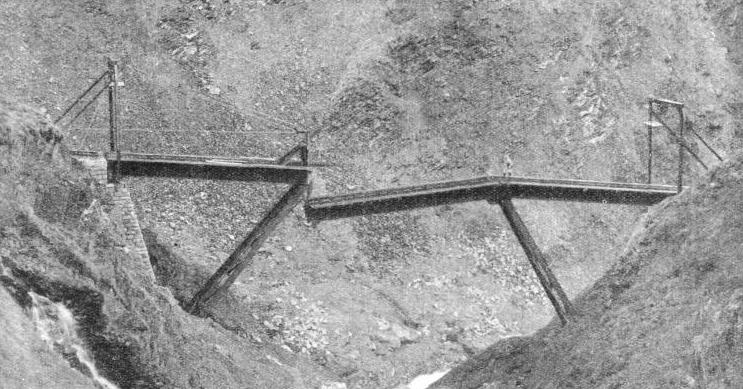
THE STEFFENBACH BRIDGE on the Furka-
SNOW is one of the most serious obstacles that the railway engineer must overcome (see the chapter “Floods, Fire and Earthquake”).
One of the countries chiefly affected is Switzerland, where a large proportion of the surface area is situated above the permanent snow-
But it is not the mere depth of snow-
On high-
Something quite trivial, like a sudden gust of wind, will cause one of these masses of snow to break loose. The danger is the greatest in the spring and early summer, when the melting of the snows has begun, and the foundations of these deposits become undermined. Deprived of support, the mass of snow starts to slide rapidly downwards.
Fortunately many avalanches spend their force high up in the mountains. Others follow the regular avalanche tracks — which the traveller in Switzerland can easily recognize by the deep furrows that the avalanches have scored in the mountain-
On the Rhaetian Railway of Switzerland a serious accident once occurred, between Davos and Klosters, near a village called Wolfgang, when an avalanche came down suddenly from the neighbouring mountains and derailed a passing train.
A similar accident occurred a few winters ago on the small railway that connects Visp, in the Rhône Valley, with Zermatt, the popular mountain resort of south-
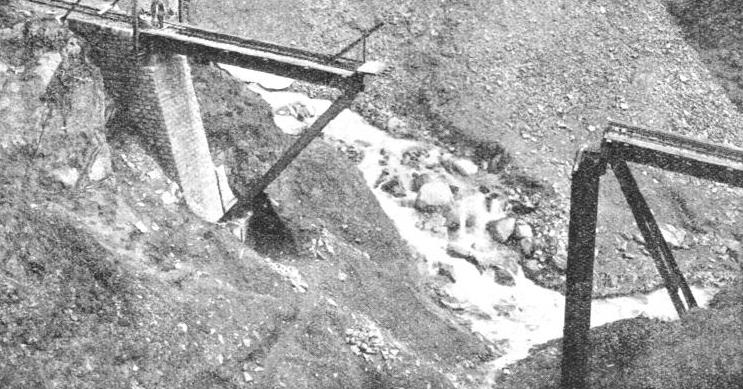
SECOND STAGE. The bridge with its centre span hanging vertically on the right. In mid-
But the Swiss are a resourceful people. Without any loss of time they excavated a tunnel through the avalanche, lined it with timber, and ran their trains up to Zermatt under the snow and ice until the spring sun came. Since then the railway has been diverted and securely roofed-
Generally speaking, avalanche dangers are greater at the higher altitudes. The site of the avalanche destruction between Randa and Zermatt is roughly five thousand feet above the sea; where the train was derailed on the Davos line the track is higher still.
The perils are the greatest when a railway is carried on a shelf that has been blasted out on some almost perpendicular mountain-
On such a line as the Lötschberg Railway in Switzerland, therefore, where it passes down the four miles of the Lonza Valley between Goppenstein and Hothen, high up on the east side of this V-
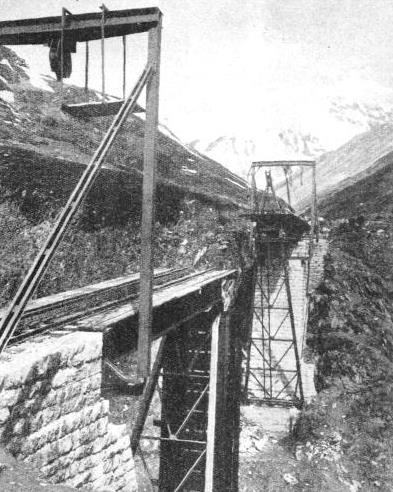
THIRD STAGE. The strut under the far side of the Steffenbach bridge is swinging back towards the masonry abutment, and the span on the far side is being drawn back to rest on the track.
But the avalanche protection is not confined only to the immediate vicinity of the line. If the passenger over the Lötschberg were to climb some of those formidable slopes above the line, in the Lonza Valley, he would find what might appear to him to be the remains of early Swiss fortifications, resembling isolated sections of the Great Wall of China. All these short masonry walls are related to the railway below. They have been erected at strategic points all over the mountain-
Shortly after the war the Furka-
As the traffic carried by this line is, for the most part, only summer tourists, the expense of protecting the line from drifts and keeping it clear from snow throughout the winter would not be justified.
The Avalanche Outwitted
Thus, except for traffic up the valleys at the two extreme ends of the line, and for trains run for ski and toboggan enthusiasts from Andermatt up to the Oberalp Pass during the winter-
After an emergence from the Furka Tunnel at the east end, the railway comes out into the upper end of the Reuss Valley, and has not proceeded more than half a mile when it has to cross a lateral gorge, down which there flows the Steffenbach, a tributary of the Reuss. Owing to the configuration of the mountains above, the Steffenbach ravine is a notorious centre for avalanches throughout the early part of the year. Massive, swift, and destructive avalanches they are, too; so much so that in the spring after the Furka-
The bridge lies at a considerably higher altitude than any of the lines previously mentioned, and at a very inaccessible spot.
The photographs illustrating this chapter show quite clearly the method of construction and of dismantling. The bridge consists of three spans, supported on masonry piers at each end, and in the centre by two diagonal steel trestles, which normally incline upwards from the base of the masonry piles, at an angle of about 45 degrees. At the ends of each of these trestles or struts are hinges, which play an important part in the work of dismantling and reassembly. The middle girder span of the bridge is also independent of the two side spans; at one end it is bolted to the adjacent side span, and at the other end it is carried on a hinge. At each end of the bridge there may be seen above the track a steel arch, carrying the permanent tackle which is used in the dismantling operations.
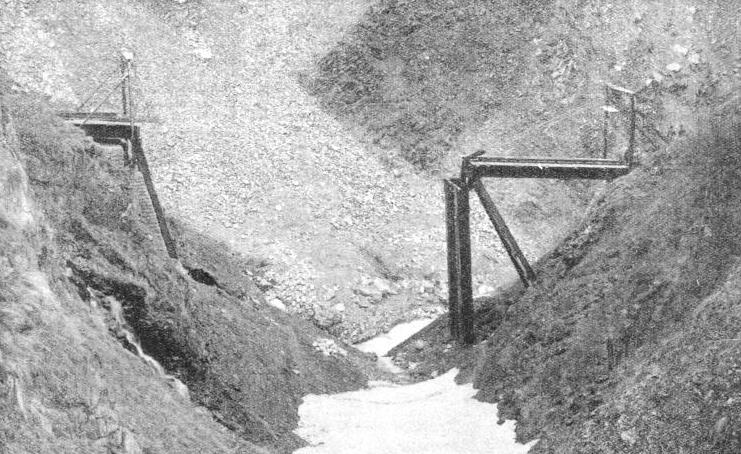
NEARING COMPLETION. The left-
In the first of the photographs dismantling has just begun. The centre span has been unbolted at the left-
It will be noticed in these pictures that the track is provided, in the centre, with the steel rack used in mountain railway working, for this is on a steep section of the Furka-
The side span on the opposite side of the bridge is then tackled in the same way. But as its supporting trestle swings round on its hinges, it brings with it also the centre span of the bridge. This swings on the hinge by which it is pivoted to this side span, so that when this trestle comes up flat against its abutment, it has the centre span resting snugly against it.
In this way the Steffenbach gorge is completely freed and the avalanches can come down and do their worst without giving the engineers a moment's concern.
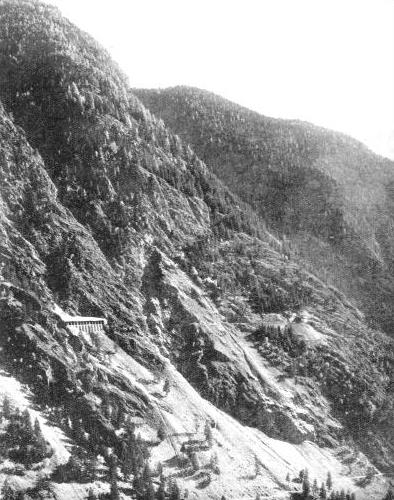 In the late spring the engineers return, and a short spell of work is sufficient to draw the various sections of the bridge from their winter resting-
In the late spring the engineers return, and a short spell of work is sufficient to draw the various sections of the bridge from their winter resting-
PATH OF THE AVALANCHE. The railway, emerging on to the open mountain-
You can read more on “Floods, Fire and Earthquake”, “Through the Bernese Alps” and “Wonderful Alpine Ascents” on this website.